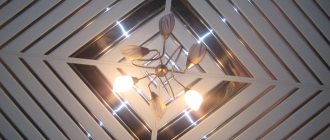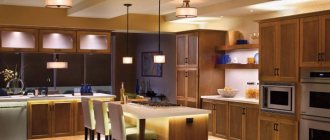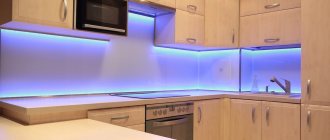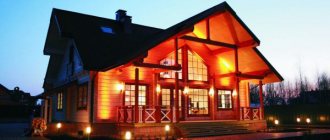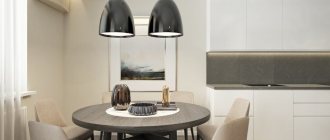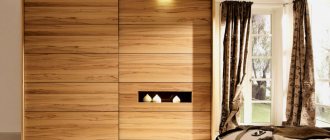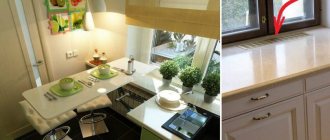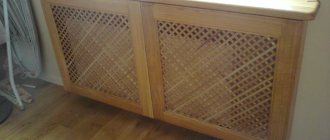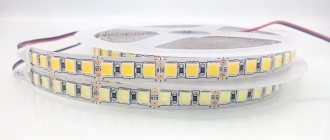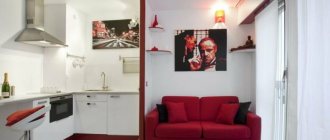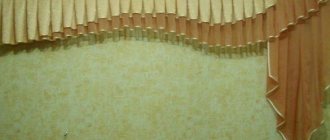Kitchen lighting under cabinets — desirable elements of the lighting system. Ceiling light sources are not enough. After all, during work a shadow is formed from the human body, and this can lead to injuries. Additional lighting installed under cabinets not only increases safety and creates more comfortable conditions for working with cutting objects. With proper planning, the design of the room itself is emphasized.
Lighting can make interior design more sophisticated
Backlight planning
Before buying any lighting fixture, determine its location and layout. There are several ways to place lamps: near the wall, closer to the doors, in the middle. It is best, according to designers, to install lamps as indicated in the last two options . Then fewer shadows are formed, which increases the safety of working with cutting and stabbing tools.
Ways to illuminate the work area in the kitchen
However, the last two options have disadvantages: often such placement is not very aesthetically pleasing. In addition, if there is a dining table or sofa opposite, the light disturbs the people there. In this case there is also a solution. A decorative strip is placed on the edge of the wall cabinet so that it covers the lighting fixture. The additional element also softens the light. The height of the bar is determined depending on the type of lamp used and its location.
Useful idea. If you don’t like the idea of a protective screen board, but there is no other choice, then you can use this element to your advantage. For example, turn it into a shelf for various small things.
In order for the backlight to cope with the tasks assigned to it, it is necessary to follow the rules for its installation.
It is recommended to install spotlights at a distance of about 40 cm, from the wall - 20 cm . One device is enough to illuminate 1.5 square meters. m.
Leave a distance of 30–40 cm between lamps
Important! If you place point light sources at too great a distance, a contrasting light “zebra” will form. To eliminate this, install additional lamps.
Spotlights
Spotlights can be overhead or recessed. For the kitchen, built-in models are usually used. One of the disadvantages of these models is their large height, which in some cases reaches 10 cm. Since the distance between the edge of the pencil case and the working surface is small - about 60 cm, it is very likely that the lighting device may interfere with work.
Spotlights are often installed above the work area
In spot models, different types of lamps are installed - incandescent, halogen, fluorescent, LED . Incandescent lamps are the least convenient. They are cheap, but they consume a lot of energy and are quite large. Another disadvantage is the strong heating of the furniture surface and low efficiency. Halogen lamps also take up a lot of space.
To save space, lamps are hidden in a cabinet. To do this, make an additional shelf inside, at a distance of approximately 5 cm from the bottom.
Spot lighting looks neat. Another advantage is that the light does not “hit” the eyes.
Find out how to make floating ceilings with lighting in our specialized article.
Control options
In response to the question of which LED strips are best for the kitchen, many designers clearly name white lighting, since it does not strain the eyes and fits well into any environment. But if you wish, you can make multi-color lighting.
The LED strip can turn on and/or change colors when connecting controls:
- motion sensors;
- touch buttons;
- remote control.
It’s worth showing your imagination, and you can get a beautiful and comfortable work area in any room.
Rotary lamps
A convenient way to illuminate a work area is rotating lamps . They come in both built-in and wall-mounted types. One of their advantages is the ability to direct the light beam in the desired direction.
Devices with a rotating mechanism can be built-in or mounted. Built-in devices are usually point-type, and are implanted into the bottom panel of wall cabinets.
The lampshade of mounted analogues is often mounted on a bracket. These devices can be quite compact. But given the limited space, this is not the best choice. Designers also believe that such lighting creates a cluttered effect, especially in small kitchens, and makes cabinets visually heavier.
Lamps on brackets are not the best lighting
Where can you install LED strips?
The choice of LEDs for kitchen lighting is largely determined by the tasks that such lighting performs:
- at the bar counter – visually highlights this space, creating the effect of a real bar;
- near wall niches, cabinets - illuminates dishes and other contents of shelves. You can make lighting with sensors, when the light turns on only when the doors are opened;
- under the upper cabinets, inside the apron or in the hood above the stove - it illuminates the cooking area and creates a spectacular atmosphere;
- on the cornices - focuses on windows, curtains;
- above the wall cabinets - visually makes the room higher, gives a feeling of “airiness”;
- under floor cabinets – creates the effect of “floating” furniture;
- near shelves, stained glass windows, paintings - emphasizes interior elements, etc.
As you can see, different lighting options are possible. The choice depends on the desires and budget of the owners. The main thing is that the lighting in the kitchen should be beautiful, safe, and fulfill its functions.
Linear backlight
This method is convenient because it provides almost uniform illumination of the work area. For this, three types of equipment .
LED Strip Light
This is a flexible printed circuit board on which LEDs and resistors are glued. The tape is produced in widths from 8 to 20 mm . The device is sold in rolls of 1-30 m . LED strips are available in one color or three colors. But the latter are used quite rarely to illuminate the kitchen area.
The lighting operates on DC power and is connected to a DC voltage of 5-24 V. Therefore, an additional converting power supply will be required. The ribbons can be used to control brightness. If the device contains diodes of three colors, then adjustment can be made for each of them. A control panel is often included with the tapes.
One of the advantages of strip lighting is that the light source does not take up much space. It is attached to furniture or a wall using the back adhesive side.
Attention! Quite often there are reviews that the tape attached in this way quickly lags behind. To prevent this from happening, experienced craftsmen recommend using additional double-sided mounting tape or stapler clips.
It must be taken into account that most products are limited in the length of the sections connected in series. So, the recommended footage is no more than 5 m . If a longer length of tape is used, then a parallel connection scheme is used. The cross-section of the wire also matters. The further from the block to the tape, the greater this indicator should be.
LED strip wound on a reel
Prices for LED strips
LED Strip Light
The advantages of this lighting method include:
- affordable price;
- low cost of operation;
- reliability;
- longer service life compared to fluorescent lighting devices;
- does not overheat;
- no moisture protection required;
- electrical safety.
Disadvantages include high cost compared to conventional light sources and incompatibility with old fixtures.
Step-by-step instructions: how to make lighting with LED strip in the kitchen with your own hands
To implement the project you will need the following items and materials:
- tape with power supply (adapter) - along the length of the cabinets on the wall above the work area;
- connecting cord (0.6 mm2);
- wire with plug;
- double-sided adhesive tape;
- insulating tape.
This is what the LED strip looks like on kitchen cabinets
Installation of work area lighting is carried out in the following order:
Step 1. The surface of the cabinets must be cleaned of dirt and then degreased. This must be done so that the tape adheres well and does not fall off during operation.
Wiping the surface from grease
Degreaser prices
Construction degreaser
Step 2. Next, you need to cut the tape according to the length of the cabinets.
Cutting the tape
Step 3. After cutting has been done, the tape must be connected to the power supply, and a cord with a plug must be connected to the power supply.
Complete structure
Step 4. At the last step, the tape must be placed on the bottom surface of the kitchen pencil cases and pressed well.
Result of work
Attention! The LED strip is cut only in areas where there are special marks. If you make a cut in other areas, the lighting device will fail and stop working.
Contact areas on the LED strip that are allowed to be used for cutting
The power supply is hidden , but in such a way that it can be taken out in the event of a breakdown. An infrared switch can be used in the circuit between the block and the plug, making it easier to control the device.
Video – LED lighting for the kitchen work area
Lamps-bars
They can be based on a fluorescent or LED lamp. The advantage of this lamp is its oblong shape. Thanks to this, one device can illuminate a fairly large area of the tabletop.
Typically, such devices are quite lightweight and easy to install. To attach LED analogues, double-sided tape is sufficient . The advantage of lighting with slats is that there is no need to damage the furniture. In addition, they are easy to move to a new location.
Selection of cable cross-section
During installation, any cables with a cross-section from 0.5 to 2.5 mm2 are suitable. To accurately select the cross-section, you should use the following formula before installation:
Designations:
I is the current strength in the circuit; calculated by the formula: I = P/U, I = U/R, where P is the source power, U is the voltage, and R is the resistance;
p—resistivity; the value of this value is always constant, taken from reference books for different metals;
l — cable length in meters;
— a value characterizing the permissible voltage difference between the unit and the backlight.
Consider a table of power depending on the characteristics of the wire. The larger the cable, the less power is transferred to the backlight.
| Length, m | Output power, W | |||
| Section area, mm2 | ||||
| 1,5 | 2,5 | 4 | 6 | |
| 50,0 | 50,0 | 50,0 | 50 | |
| 2 | 45,5 | 47,2 | 48,2 | 48,8 |
| 4 | 41,5 | 44,6 | 46,5 | 47,7 |
| 6 | 38,1 | 42,3 | 44,9 | 46,5 |
| 8 | 35,0 | 40,1 | 43,4 | 45,5 |
| 10 | 32,4 | 38,1 | 42,0 | 44,4 |
Surface-mounted lamps
Surface-mounted lamps are also a fairly wide group of lighting devices, which are widely used to illuminate the work area in the kitchen. The type of lamp here can be very different. The convenience of overhead devices is that damage to furniture will be minimal. However, then you need to take care of how to hide the wires. Therefore, the wiring is hidden in the wall, when placed vertically, or under the bottom panel of the kitchen cabinet.
Aprons with internal lighting can turn the kitchen work area into the wall of an aquarium
How are overhead lamps attached?
There are several ways to mount the device on the surface of a wall or kitchen unit .
In the first case, screws are used. Some devices have an adhesive backing. In this case, it is enough to remove the protective layer and attach the device with the adhesive side to the base on which the lamp will be held.
Recommendations for illumination and light temperature
Kitchen lighting is included in the overall kitchen lighting project.
This refers to the illumination of the worktop and equipment, as well as the upper part of the set. Lighting for drawers or cabinets from the inside can be installed regardless of the lighting level in the room. The general requirement for a kitchen is 150 lux per square meter . The requirement is the same for the dining and working areas. To calculate the required lamp power, determine the illuminated area - usually the worktops and stove - and multiply the value by 150 lux.
The result is divided by the number of lamps that are supposed to be installed. Based on the results obtained, lamps of suitable power are selected.
You also need to take into account the temperature of the light . This indicator determines the shade. For functional lighting, warm white light with a temperature of 2700 K is recommended, natural daylight - 4200 K, and cold light - 6400 K.
Warm light is recommended for a large kitchen, cold light for a small one, as such lighting visually expands the space.
Lighting for glass splashbacks
Illuminated glass aprons look incredibly impressive. Then the lighting fixture is not visible. It seems that the wall itself is glowing. Quite often they use glass with landscapes of the city and nature. Then you get the impression that there is a large panoramic window under the cabinet.
Halogen lighting fixtures are often used for this purpose. However, experts say: these lamps are not suitable because they create glare on a glossy surface. Most often, fluorescent lamps that provide uniform light and LED lamps are installed.
In addition to the traditional method of placement under the cabinet, lamps are also placed behind the panel . This not only makes the picture unusually realistic, especially in the dark. This lighting design is also practical: all the wires can be hidden behind the glass.
There are two more conveniences in such lighting:
- lighting fixtures are protected from moisture, soot and dust do not settle on them;
- Tempered glass, which is mainly used for finishing the work area, does not burn or melt.
Step-by-step instructions for making a skinali with backlight
The luminous apron is installed after the repair has been completely completed and the pencil cases have been installed. Before installing the system, measurements are taken. If there are old sockets or other objects on the wall, they are dismantled. Apply insulating tape to exposed wires.
Installation of the panel is carried out in the following sequence:
1. Make a canvas with LED strips, which is attached directly to the wall. It consists of foil (foil, paper base, polyethylene). An LED strip is glued on top of the foil in a horizontal direction, leaving a step of 5-10 cm between the rows. The wider the step, the dimmer the emitted light will be.
2. Attach the backlit foil to the wall. To do this, use an adhesive that is suitable for this surface. Where the sockets should be, holes are made through which the wiring is routed.
Foil with tapes is attached to the wall with glue or using double-sided tape
3. Install a frame made of wooden slats. The wood is pre-treated with antifungal and insecticidal drugs. Where the lath comes into contact with the wall, sealant is applied. Particular attention is paid to the area next to the sink.
4. Route the wiring of the backlight itself to the side where the control units will be located.
5. Install skins. If the working area is L-shaped, first install the corner profile. Then the lower holders are secured.
6. Insert the glass panel and, holding it at an angle of 45°, put the top profile on top of it. Secure the slats.
Systems for fastening skinnels with seals
What do we need for installation?
Self-installation of LED backlighting will require the use of the following tools and components:
- The actual kit: tape reel (12W), electrical cable with a cross section of 0.74 mm square;
- Transformer - 12W power supply and dimmer with remote control (if available);
- Solder with rosin;
- Soldering iron;
- Scissors;
- Double sided tape;
- Insulating tape (or heat shrink tube with a heat gun);
- PVC corner and or aluminum profile for LED mounting – if necessary;
- Drill - if necessary;
- Electrical installation brackets - if necessary.
Wireless kitchen lights
This is one of the most convenient lighting options for the kitchen. Such devices operate on batteries or adapters . They don't need a power source. They are often part of a smart home system, so they are often equipped with motion sensors, which saves power consumption. Their main advantage is independence from the location of the outlet. You also don’t have to look for where to hide the wires.
Battery-powered lamps are convenient because they do not depend on the location of the outlet
But these lamps also have a drawback - you will have to constantly change the batteries or recharge the batteries .
Prices for wireless LED lamps
Wireless LED light
How to choose the color of lighting for the kitchen
When choosing a lamp, it is important to consider the color rendering index. On the packaging it is designated by the abbreviations Ra or CRI . This determines how correctly the color of the products will be displayed. The color is not distorted if Ra corresponds to 80...100 .
Apple color at different color rendering index values
Color temperature is also important for correct color rendering. This indicator is measured in Kelvin (K).
Table 1. Shades and color temperature values.
| Hue | Color temperature, K |
| Warm | 2700-3000 |
| White (neutral) | 4100 |
| Cold | 6500 |
A cool shade will help you concentrate on work. Warm shades relax and create a feeling of comfort. Neutral does not distort colors.
Reference. When choosing a shade, designers advise taking into account not only the influence of the color shade on the psyche, but also the color of the furniture. So, for wooden sets they advise giving preference to the warm zone of the spectrum, for high-tech style - cold ones.
Installing an outlet on a kitchen apron
If wired lighting devices are used for lighting, then you should consider the location of the outlet. There are no safety requirements. However, when choosing a place to place it, pay attention to the following points:
- The outlet should not be placed directly above the countertop. The nests will become clogged and moisture may enter. Therefore, the distance to the surface of the tabletop should be at least 10 cm.
- To visually hide this unit, you can place it closer to the edge of the wall cabinet. Another additional plus is greater comfort of use.
As for choosing a horizontal location, it all depends on what devices will be used. If they are concentrated on one side, then the socket must be installed there too.
If you want the outlet to be hidden, then you can choose corner outlets. The back side of these devices is attached to the wall, the top side is attached to the bottom surface of the cabinet . Thanks to this design, they are unnoticeable and do not spoil the appearance of the apron.
Corner socket models are mounted under the kitchen cabinet, which makes them invisible
Prices for various socket models
Corner socket models
You can also use socket models built into furniture. Sometimes they are built directly into the countertop. This further increases the risks compared to placing the device low on the wall, even if a protective cover is used for the tabletop model. In addition, according to the Electrical Installation Rules, contact of electrical installation products with flammable surfaces, such as wood furniture, is limited. To reduce risks, steel embedded boxes are used.
One of the latest developments is a hidden socket . This is a type of hidden socket, but in this case, thanks to a special mechanism, the block extends above the tabletop. Disadvantage: low power. Such sockets are not suitable for devices with a power of 1.5 kW and above. However, lighting devices do not reach these indicators.
The range of lighting fixtures and options for illuminating the work area is quite large. Therefore, choosing the right option for yourself will not be so difficult.
